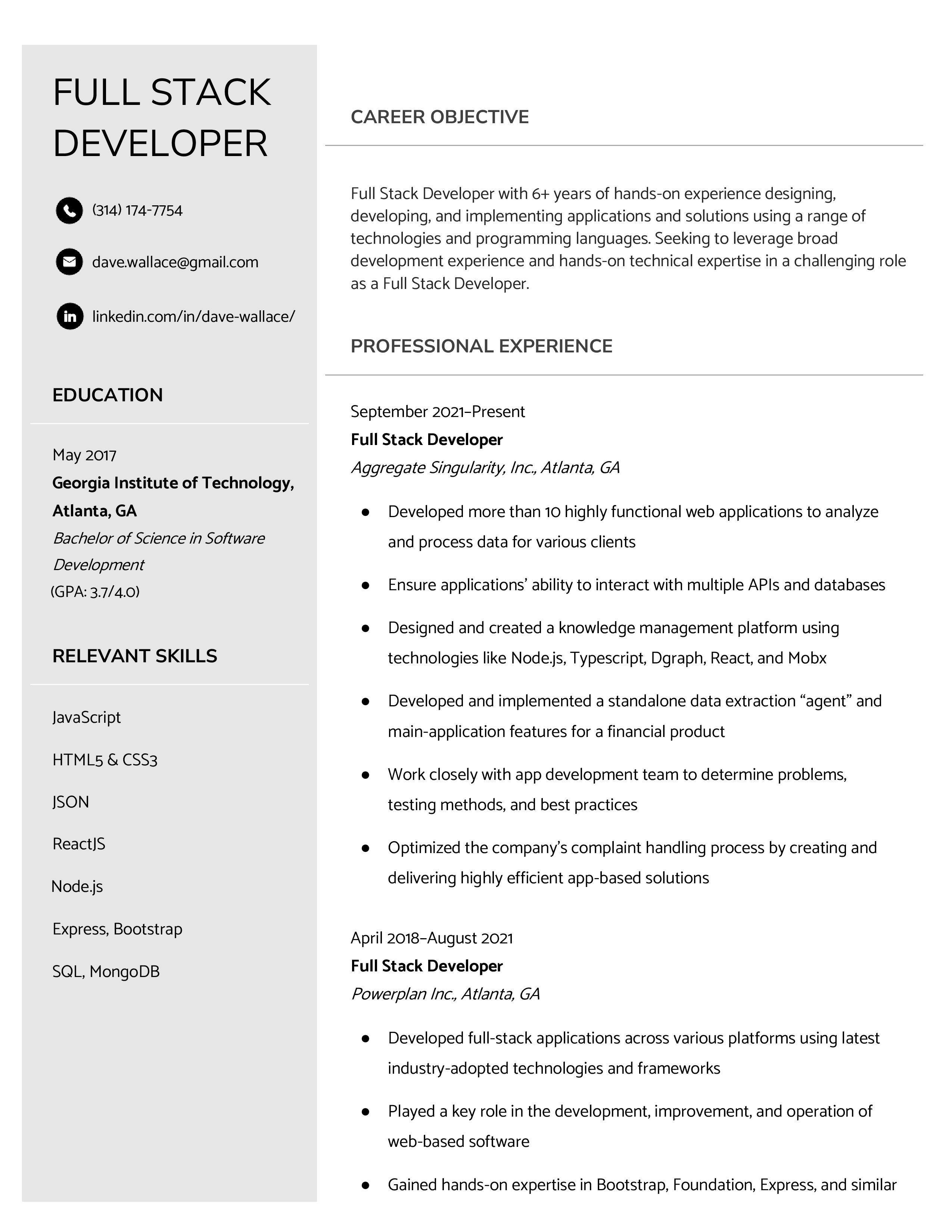How to create an outstanding full-stack developer resume
Published on October 6th, 2024
Demand for full-stack developers is on the ascend as businesses look for technologists who can develop skill-sets across the stack from front-end interfaces to back-end servers. Having a great resume is an important thing for this seasoned pro who wants to be a wannabe full-stack developer and can get the dream job.
Let's discuss in this blog how to write an effective full-stack developer resume, highlighting skills, experience, and value it can bring to potential employers.
About Full-Stack Developer
A full-stack developer is one type of software engineer proficient enough to work on the front-end and back-end of web applications or software. Thus, with such knowledge and skills, a full-stack developer can control all the parts related to the client-facing side of an application, which comprises the front-end, and all the server-side parts, known as the back-end. Such versatility and value make full-stack developers highly sought after today in the fast-paced world of technology, and they can deliver such complex projects right from the ground.
Check out the free template for full-stack developer resumes.
Guidelines for Creating a Full-stack Developer Resume
1. Construct a Strong Resume Summary
Your resume summary is a synopsis of your knowledge that grabs the eye of the hiring manager. Since human resource managers scan resumes, you want to catch their attention by having a snapshot of who you are.
Example: "Full-stack developer with more than 5 years of experience developing scalable web applications with JavaScript, React, Node.js, and MongoDB. Made sure you would be able to design and implement efficient user-friendly interfaces and back-end APIs. Passionate about clean and maintainable code."
2. How to list relevant technical skills
Technical skills form the core of any full stack developer's work. Create a separate section for technical skills mentioning front-end and back-end technologies that you are good at. Both specific tools, frameworks, and programming languages you are comfortable with are included.
- Front-End Skills:
- HTML5, CSS3, JavaScript
- Frameworks: React.js, Angular, Vue.js
- Responsive design, Bootstrap, Tailwind CSS
- Back-End Skills:
- Skills in Node.js, Express, Django, Ruby on Rails
- Databases: MongoDB, MySQL, PostgreSQL
- RESTful APIs, GraphQL
- DevOps and Other Skills:
- Git, GitHub, Jenkins, Docker
- AWS, Google Cloud, Azure
- Unit testing, automation (Jest, Mocha)
3. Demonstrate Your Skills with Projects
Projects that you have worked on are probably one of the most effective ways to show off what you can do. Add a "Projects" section and describe major projects you have worked on or contributed to. You should list the technologies used, your own contribution, and the impact of the project.
4. Working Experience
Your experience should be about the work related to the role that signifies your capability as a full-stack developer. Your achievement using bullet points shall be quantified as much as possible. Example:
Full Stack Developer, ABC Tech (2019-Present)
- Built and maintained full-stack applications on React, Node.js, and PostgreSQL on client projects, which reduced system downtime by 30%.
- Designed and implemented APIs that saw performance improvements of 25% in the app with smooth integration of third-party services.
- Managed a team of three developers to design scalable architecture for a SaaS product, seeing engagement increase by 15% among users.
5. Education and Certifications
If you have a formal education in computer science or a related field, include it here. Likewise, if you have relevant certifications or courses you have completed, such as:
Bachelor's Degree in Computer Science
Full Stack Web Development Certification
(e.g., Coursera, Udemy, Codecademy)
AWS Certified Developer – Associate
6. Soft Skills Matter
While your technical skills are important, most full-stack developers are expected to work with other teams and communicate effectively. Add soft skills like problem-solving, teamwork, and communication to point out that you are not a code machine.
Example:
- Exceptional problem-solving skills: can resolve production issues against tight deadlines.
- Strong collaborator with cross-functional teams to produce high-quality software solutions.
7. Tailor Your Resume to the Job
Tailor your resume for every job application. Customize your resume to fit each job description by emphasizing the abilities and experience that will best appeal to the potential employer. Often, it can be that little change that makes the big difference in showing yourself to hiring managers.
Final Words
Your resume must not be more than two pages long (be concise).
Use action verbs such as "developed", "implemented", "designed" and "optimized".
Never forget to proofread for spelling and grammar errors.
Focus on showcasing your technical skills, examples of projects you have worked on, and experience-relevant sectors, which will show that you are a full-stack developer and thus make an effective impact on your potential employers.
Authors

Yash Chaudhari
With a strong background as an SEO and Content Specialist, Yash excels in driving organic traffic, improving search engine rankings, and creating SEO-optimized content. He has a proven track record of implementing strategies that increase website traffic and conversions. Additionally, Yash is an automotive enthusiast and has a keen interest in astronomy.
Hire the best without stress
Ask us how
Never Miss The Updates
We cover all recruitment, talent analytics, L&D, DEI, pre-employment, candidate screening, and hiring tools. Join our force & subscribe now!
Stay On Top Of Everything In HR


